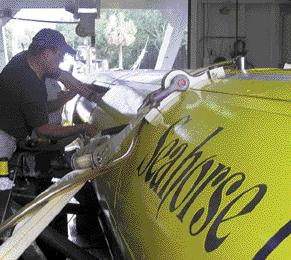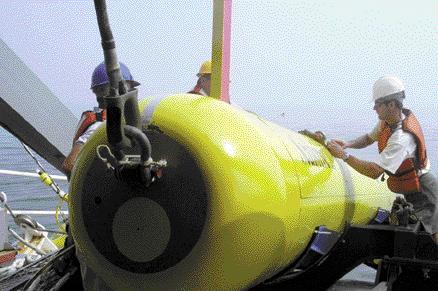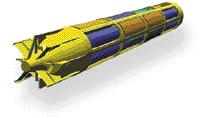
11 minute read
Seahorses and Submarines: Transformational UUVs
(above) SEAHORSE engineers work on a module insi de one of the SEAHORSE 2 bays.
(above right) SEAHORSE 2 is being prepared for launch from the IC-508 AUV Support Vessel.
Advertisement
by Craig A. Peterson and Martha E. M. Head
SEAHORSES and SUBMARINES SEAHORSES and SUBMARINES Testing transformational capabilities Testing transformational capabilities with modern UUVs at NAVOCEANO with modern UUVs at NAVOCEANO

For the past 40 years, the Naval Oceanographic Office (NAVOCEANO) has been the Navy’s primary source of environmental data and analysis products to support navigation and performance prediction for weapons and sensors. And similarly, NAVOCEANO will be the primary source of environmental information for supporting the operation of unmanned undersea vehicles (UUVs) in the future.
Located at the John C. Stennis Space Center near the Gulf of Mexico in southern Mississippi, NAVOCEANO has a 172-year history of military ocean survey. Ocean data is collected worldwide by a dedicated fleet of eight survey ships, supplemented by ships of the University National Oceanographic Laboratory System (UNOLS) fleet and airborne and subsurface craft. Complementing this array of platforms are drifting and moored buoys, as well as satellites. NAVOCEANO uses this information to generate environmental products tailored to the warfighters’ needs, and we support virtually every current fleet operation. Examples of the environmental information NAVOCEANO supplies can be viewed on the Internet at http://www.navo.navy.mil.
SEAHORSE UUVs for Ocean Survey – and more
In a key naval transformation effort, NAVOCEANO has volunteered a fully-autonomous SEAHORSE-class UUV to the Undersea Technology Di rectorate of the Na val Sea Systems Command (NAVSEA) for use in the first of a series of Transformational Payloads and Sensors Demonstrations for the SSGN submarine conversion program. In the planned demonstration, the SEAHORSE UUV will be launched from an SSBN missile tube and will conduct a long-range, multi-mission mine countermeasures (MCM) operation. The demonstration will also feature an oceanographic survey.
As an example of why it is important to understand the details of the underwater environment in UUV areas of operation, this three-dimensional visualization of the current field at the Strait of Hormuz shows enormous variability in both speed and direction from surface to bottom. The viewer is looking from the Gulf of Oman into the Arabian
Gulf, and although the maximum depth of the strait is only 105 meters, the vertical scale is exaggerated here by a factor of over 1,000. NAVOCEANO’s Shallow-Water Analysis and Forecast System (SWAFS) generated this prediction.
SEAHORSE was introduced recently by N AVOCEANO as an economical, longendurance, autonomous UUV for collecting oceanographic data. It followed a technology program at the Defense Advanced Research Projects Agency (DARPA) that was transitioned to the Navy several years ago. Low cost and rapid development were possible largely because, for oceanographic missions, some military standards for robustness could be relaxed. SEAHORSE was developed at the Pennsylvania State University Applied Re s e a rch Laboratory (Penn State ARL), which was able to leverage substantial previous work in UUVs and UUV propulsor technology.
These fully-autonomous UUVs are force multipliers for oceanographic survey ships collecting high quality data in the littoral regions of the world. Intended to operate primarily from the Navy’s USNS Pathfinder (T- AGS-60)-class military survey ships, SEAHORSE has a sturdy, yet adaptable, design and the long endurance needed for both demanding ocean conditions and deployment from either platforms of opportunity or even shore stations.


Penn State ARL delivered SEAHORSE 1, the demonstration. Consortium members are the vehicle planned for the SSGN Raytheon Corporation, General Dynamics Demonstration, to NAVOCEANO in Electric Boat, Boeing, and Rite-Solutions. October 2000. It executed its first operaBesides NAVOCEANO, other participants tional survey from USNS Bruce C. Heezen in this demonstration include Penn State (T- AGS-64) a year later. The vehicle is ARL and the Na val Undersea Wa rf a re presently equipped with a 150-kHz sideCenter facilities at Newport, Rhode Island scan sonar, a 300-kHz acoustic Doppler and Keyport, Washington. c u r rent pro f i l e r, a mast-mounted global SEAHORSE will deploy vertically from a positioning system antenna, and an inertial TRIDENTmissile tube on the SSBN, rotate navigation system. SEAHORSE 2 was delivto its normal horizontal configuration, and ered in October 2001 and is currently in then swim up to 200 miles before launching underway testing. Penn State is a simulated mission payload at a predeteralso fabricating a third operational mined point. Oceanographic data and sidevehicle, SEAHORSE 3. scan sonar images will be collected during
SEAHORSE construction is the mission. Then SEAHORSE will be modular to facilitate field mainterecovered onto a T-AGS-60-class military nance, rapid mission turnaround, survey ship, much as it would be in a conand payload flexibility. With an ventional oceanographic mission. integrated afterbody for propulsion and hydrodynamic control, plus NAVOCEANO’s UUV Forerunners variable ballast systems fore and N AVOCEANO has strong ties to aft, the UUV can execute a variety g overnment, commercial, and academic of high-level commands, such as organizations with UUV interests. These maintaining a constant depth, ties facilitate an active, affordable program course, and speed; navigating for oceanographic and bathymetric between waypoints; and conductmeasurements. ing search and survey patterns. For many years, NAVOCEANO has used Typical mission operating depths tethered or towed unmanned vehicles f o r range from 15 to 1,000 feet, with undersea exploration. Side-scan sonar, liket h e endurance up to 72 hours. SeaMap system transitioned from a program SEAHORSE vehicles are 28 feet at the University of Hawaii, is used for long, slightly more than three feet in low- to medium-resolution surveys. Another d i a m e t e r, and weigh 10,500 pounds. example is the Towed Oceanographic Survey Standard alkaline batteries (D-cells) power System (TOSS) developed at Woods Hole the vehicle, allowing a 300-mile range. Oceanographic Institution (WHOI). TOSS N AVOCEANO plans to transition to is towed very near the sea floor (often just 5 rechargeable lithium-ion battery technology meters above) for ve ry high-re s o l u t i o n in the near future. bottom mapping. It has side-scan sonar for acoustic images and both still and video SSGN Mission Demonstration optical cameras. For both of these systems,
N AVSEA will deploy SEAHORSE in the towing cable provides mechanical January 2003 from a USS Ohio (SSBNcontrol and maintains fiber-optic communi726)-class submarine. In addition to cations with the survey party. demonstrating the feasibility of launching a In the late 1980s through mid-1990s, SEAHORSE-size vehicle from an SSBN’s the semi-submersible ORCA vehicle, a missile tubes, Experiment “Giant Shadow” d i e s e l - p owe red, remotely-operated surve y will illustrate how the combination of platform, provided NAVOCEANO some Special Operations Fo rces, unmanned useful experience with vehicles (both airborne and undervehicles that did not water), and an SSGN re q u i re a mechanical can provide the t e t h e r. The Na va l joint commanRe s e a rch Laboratory der with new (NRL) and Chance and c a p a b i l i t i e s . The “Fo rw a rd Pass Consort i u m” was selected by This computer-ai ded rendering of SEAHORSE shows its modular battery and payload bays. The vehicle is nearly 28 feet long by 38 inches in diameter and weighs nearly five tons. Mission NAVSEA to conduct range is 300 nautical miles, and en durance is 72 hours.
Chance, Incorporated (through an associated Cooperative Research and Development Agreement) led the adaptation of ORCA for oceanographic applications. The vehicle, though unmanned, was far from autonomous. It had to maintain “line-of-sight” radio communications with the mother ship, and since it operated at the surface, it had to be kept under constant visual observation to ensure the safety of local shipping. Later, the ORCA concept was adapted for the surface-ship Remote Mi n e h u n t i n g System (RMS).
NAVOCEANO’s first fully autonomous UUV was transitioned in the late 1990s from the discontinued Defense Advanced Re s e a rch Projects Agency (DARPA) pro g r a m mentioned above. The actual ve h i c l e , designed and built at Draper Laboratories –and named Lazarus at NAVOCEANO –incorporated advanced technologies and offered long range and reliable autonomy. Although the DARPA vehicle’s monolithic c o n s t ruction was not suitable for field maintenance aboard oceanographic ships, it served well on NAVOCEANO’s Gulf of Mexico range to provide the experience that helped make the SEAHORSE class affordable and effective.
Cu r re n t l y, the SEAHORSE group of vehicles, including the SSGN demonstration’s SEAHORSE 1, is the backbone of NAVOCEANO’s untethered fleet. However, a semi-autonomous UUV, the Semi Autonomous Mapping System (SAMS), is also being a c q u i red from WHOI. SAMS is an ou grow t h of Woods Hole’s Remote Environ-m e n t a l Monitoring UnitS (REMUS) pro g r a m and will operate primarily in conjunction with TOSS surveys. It is “f u l l - o c e a n - d e p t h” capable (i.e., to 20,000 feet) and has 12-hour endurance. SAMS could readily be conve rt e d for fully autonomous operation, but it is now designed for use within a coned-shaped volume of acoustic control transmissions under an oceanographic ship. Like TOSS, it will collect high-resolution side-scan images by working very near the bottom. SAMS has completed in-water testing with deployment from a T-AGS-60 platform. Its first operational survey with full operating capability will be in May 2003. Information on SEAHORSE and other NAVO C E A N O UUV projects are also available on the Web site noted previously.
To maintain close ties with industry and academia, NAVOCEANO, along with its second-echelon command, Commander, Na val Me t e o rology and Oc e a n o g r a p h y
( a b o v e ) T he Semi-Au t o no mous Ma p p i ng System (SA MS ) is a smaller, acoustically-controlled UUV capable of 12- hour mapping missions to a maximum depth of 20,000 feet. Here, it is prepared for launching from USNS Bruce C. Heezen (T-AGS-64).
(below) An earlier unmanned platform, the Towed Oceano-g ra p h i c Survey System (TOSS) is typically tra i l e d b e h i nd a survey ship and positioned as close as 15 meters above the bottom to do hi g h - re s o l u t ion ma p p i ng .
Command (COMNAV M E TO C C O M ) , and the Office of Naval Research, sponsor biannual Autonomous UUV (AU V) demonstrations on NAVOCEANO’s Gulf of Mexico test range near Gu l f p o rt , Mississippi. These “AUV Fests” are planned to demonstrate the application of emerging AUV technology to military hydrography and oceanography requirements.

Environmental Considerations
The forthcoming SSGN demonstration can also be expected to show in a realistic scenario the extent to which operational use of truly autonomous UUVs will require detailed knowledge of the ocean environment. Environmental information is n e c e s s a ry for advance planning, curre n t operations, and post-mission data analyses. For the approaching demonstration, this b a c k g round information includes sea surface environmental effects, as well as ocean currents from the surface to operating depths, tides, temperature and salinity profiles, and bathymetry. Other key information includes local-area fishing activities and hazards to navigation.
In general, safe, cost-effective operation of UUVs, whether for undersea warfare or c o m m e rcial and academic applications, demands a minimal set of meteorological and oceanographic information in addition to bathymetry, coastal configuration, and hazards to navigation. This information for planning, conducting, and analyzing UUV operations should include analyses and forecasts of:
• Sea state and direction for launch and recovery • Ocean current fields, including ti dal currents and ti dal cycles along the proposed track and at potential working depths • Temperature and salinity (water density) along the proposed track • Area overviews, including information about ocean fronts and eddies • Weather in the area and weather approaching or otherwise affecting ocean conditions in the operating area • Surf or river outflow for some operations • Acoustic-propagation, if acoustic communications will be used at a distance • Electromagnetic propagation, if radio communications will be used at long range
For nearly a half century, the Na va l Oceanographic Office has provided the Navy’s air, surface, and subsurface forces the e n v i ronmental data and analysis they’ve needed to best carry out their missions in harm’s way. That tradition continues as new technologies, such as fully autonomous UUVs, transform the Navy and expand its need for operational oceanography.
Craig Peterson is Director of the Ocean Projects Department at the Naval Oceanographic Office. He came to NAVOCEANO after a 30-year active-duty Navy career that included both flying helicopters and s e r v i ng in the Navy’s METOC (Me t e o rology and Oceanography) officer community.
Dr. Martha Head is an oceanographer at NAVOCEANO with broad program management experience in ocean acoustics, ocean modeling, remote sensing, and oceanographic databases.






